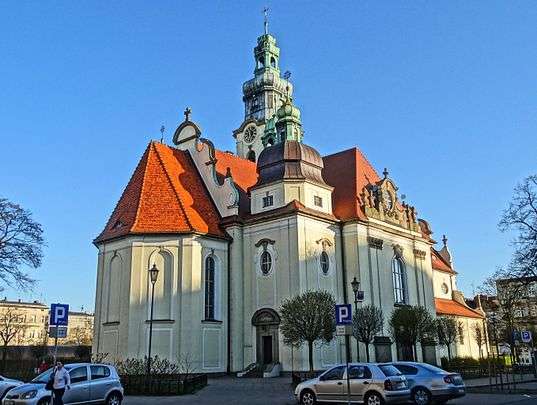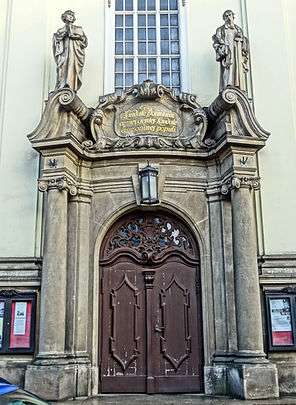Church of the Sacred Heart of Jesus in Bydgoszcz
| Church of the Sacred Heart of Jesus | |
|---|---|
| Polish: Kościół Najświętszego Serca Pana Jezusa w Bydgoszczy | |
 View of the Church of the Sacred Heart of Jesus, from Piastowski Square | |
| 53°7′55″N 17°59′53″E / 53.13194°N 17.99806°E | |
| Location | Bydgoszcz |
| Country | Poland |
| Denomination | Roman Catholic |
| History | |
| Dedication | Sacred Heart of Jesus |
| Dedicated | June 19th, 1913 |
| Architecture | |
| Status | Church |
| Functional status | Active |
| Heritage designation | 601221, Reg.A/746, December 12, 1971[1] |
| Architect(s) | Oskar Hoßfeld |
| Architectural type | Neo-Baroque |
| Completed | 1913 |
| Specifications | |
| Materials | Brick |
| Wikimedia Commons has media related to Sacred Heart church in Bydgoszcz. |


The Church of the Sacred Heart of Jesus is a historical and religious (Roman Catholic) building in downtown Bydgoszcz, Poland. It stands at Piastowski Square N°5, not far from Śniadecki Street in downtown district (Polish: Śródmieście) of Bydgoszcz.
History
The history of the church is associated with the efforts of the Polish community, which, since 1898, strived to obtain the consent of the Prussian authorities to build a new Catholic church in the city. Consent was granted released in 1906, under the condition to establish two catholic churches: one for Poles (Holy Trinity Church) and one for Germans (Church of the Sacred Heart of Jesus). The construction site for the German catholic temple was chosen at Elisabethmarkt, then a city square. The church was built from 1910 to 1913 with funds from the government, papal gift and contributions of German Catholics in Bydgoszcz.[2]
The preliminary design of the church was performed in the Department of Civil Engineering Design of Public Works in Berlin in May 1908. The main architect and builder was Oskar Hoßfeld (1848-1915), from Thuringia. He was at the time considered as a specialist in the construction of churches, such as in Poznan, Szczecin or Legnica. During the building in Bydgoszcz, he was assisted by a city senior official, Mr Herrmann and builder managers, Mr Handke and Mr Asmann. The church was built with Baroque Revival architecture features, in the like of a basilica, with an apse, a transept and an internal great domed rotunda. The style of the church refers to Baroque churches in northern Germany.[2]
Building has been consecrated by Suffragan bishop from Gniezno Wilhelm Kloske on June 19, 1913. Initially, the temple was an auxiliary church subordinated to the cathedral parish of Bydgoszcz. Reserved for the use of German Catholics, the temple was opened to both communities, German and Polish, on February 17, 1924. Until the outbreak of the Second World War, the church was the property of the municipality.[2]
In 1921, young organist Szczepan Jankowski (1900-1990) was nominated. Despite his blindness, he became a notorious composer with studies and recognitions from many universities ( Poznan, Leipzig, Munich, Berlin and Paris). For his great services to the Church, Pope Paul VI honored him in 1964 with the Medal Pro Ecclesia et Pontifice.[3] He lived at Śniadecki Street N°55, where a plaque has been unveiled in 2008 in memoriam.[3]
In 1924, Cardinal Edmund Dalbor issued a decree related to the creation in Bydgoszcz of five new parishes, including the parish of the Sacred Heart of Jesus. The first parish priest in 1925 was Kazimierz Stepczyński, murdered by Nazis in 1939.[4]
During World War II, the church has not suffered too much from the ravages of the conflict. Interiors have been refurbished from 1982 to 1988, and in 2002, a new façade and an outer illumination have been installed.
Characteristics
The temple is considered as one of the most beautiful historicism style churches built in Bydgoszcz at the turn of the 20th century.[2]
Architectural style
The church follows the Neo-Baroque style, with a plastered facade which distinguishes it from many others built in Bydgoszcz during the second half of the 19th century and the early 20th century, which are usually adorned with a high-quality ceramic and many architectural details. It has the characteristics of a basilica with a dedicated transept, over which rises the dome.[5]
The temple has three aisles, with the chancel facing north: it has two chapels, and two sacristies. It can accommodate approximately 2000 believers. There are three main entrances and two side ones. In total, the church is 812 m2 large. It is a relatively early example of reinforced concrete structure in the city. The church tower is 48.4 m high, and topped with a bulbous dome carrying with a lantern. Inside the dome, in addition to the bells, a clock tower strikes the hour and the half-an-hour. It was built in 1912 by German company Ed. Korfhage & Soehne Melle,[6] which still exists up to this day.[7] Gutters, cupola and flèche are all copper plate roofed.
The facade is distinguished by its pilasters topped with attic style decoration. The main nave, the chancel and transept sides are ornamented with barrel vaults. Nave floor is covered with red sandstone, and chancel's with marble slabs.
Architectural details
Rich baroque motifs adorne both church interiors and façade: cartouches with writings, volutes, flaming vases, putti, rococo painting ornaments, festoons.[8] The portal displays richly decorated stone statues of Saint Peter and Saint Paul. The transept boasts columns heaving balconies with statues of angels.[2]
Frescoes on vaults and ceilings have been made by artist painter Ernest Fey from Berlin. The two apostles figures of the facade portal have been realized by Schreiner from Regensburg. Exterior figures are the work of Meyer and Weber from Wilmersdorf. Interior sculptures, such as the Atlas of the matroneum organ and the four groups of angels in the transept have been created by Frank Vauschutz from Charlottenburg.
Altars
Six altars stand in the church:
- Main altar, initially decorated with the image of the Heart of Jesus by Boleslaw Lewański. It has been replaced in 1930 by the image of the Sacred Heart of Jesus, by professor Faczyński;
- Altar in the left aisle, with a picture of the Assumption of Mary;
- Altar in the right aisle, with a picture of Saint Joseph;
- Second altar in the right aisle, with a statue of Saint Anthony, by professor Giecewicz in 1924;
- Altar in the chapel adjacent to the chancel, where is now placed -since 1930- the picture of the Sacred Heart by Boleslaw Lewański, initially at the main altar;
- Altar in the chapel adjoining the left aisle, which initially housed a statue of Our Lady of Sorrows. However, it is now replaced by a stylish Baroque altar made by sculptor Skręt from Bydgoszcz, along with an image of Sainte Thérèse of Lisieux by professor Faczyński. A Pietà stands now in the right aisle.
Bells
In the church tower hangs three steel bells, with a combined weight of more than 5.6t:
- The smallest christened "Ave Maria, gratia plena Dominus Tecum" (Hail Mary, full of grace, the Lord is with thee);
- The medium christened "Omnia ad Dei Major gloriam" (All for the greater glory of God);
- The Largest christened "Cor Jesu sacratissimum Miserere nobis" (Sacred Heart of Jesus have mercy on us).
The bells are electrically powered, cast in Bochum in 1912.
Pipe organ
Pipe organ has been built in 1912 by Paul Voelkner from Bydgoszcz, as a 28 voice instrument. In 1942, it has been rebuilt by Josef Goebel from Gdańsk, and increased by one voice. In 1968, tubular bells have replaced original ones. The instrument has two keybaords and one pedal, with a pneumatic tracker (air being forced through a noiseless fan). In April 2012, a major renovation has been carried out.[9]
Gallery
 View from Śniadecki Street
View from Śniadecki Street Detail of the clock tower
Detail of the clock tower Detail of a finial
Detail of a finial- back view
 One of the main door, with Saint Peter and Saint Paul
One of the main door, with Saint Peter and Saint Paul One of the facade door
One of the facade door- The nave
- The pipe organ
See also
- Gdańska Street, Bydgoszcz
- Dworcowa Street in Bydgoszcz
- Jan and Jędrzej Śniadecki Street in Bydgoszcz
- St Peter's and St Paul's Church, Bydgoszcz
- Poor Clares' Church, Bydgoszcz
- Chapel of the Sisters of the Poor Clares, Bydgoszcz
- (Polish) Downtown district in Bydgoszcz
External links
Bibliography
- (Polish) Chamot Marek. Kościół katolicki w Bydgoszczy w czasie zaborów. Kalendarz Bydgoski 2000
- (Polish) Derenda Jerzy. Piękna stara Bydgoszcz – tom I z serii Bydgoszcz miasto na Kujawach. Praca zbiorowa. Towarzystwo Miłośników Miasta Bydgoszczy. Bydgoszcz 2006
- (Polish) Kuberska Inga: Architektura sakralna Bydgoszczy w okresie historyzmu. Materiały do dziejów kultury i sztuki Bydgoszczy i regionu. Zeszyt 3. Bydgoszcz 1998
- (Polish) Parucka Krystyna. Zabytki Bydgoszczy – minikatalog. "Tifen" Krystyna Parucka. Bydgoszcz 2008.
- (Polish) Rogalski Bogumił. Architektura sakralna Bydgoszczy dawniej i dziś. Kronika Bydgoska XII (1990). Bydgoszcz 1991
- (Polish) Rudnicki Daniel Bernard. Parafia pw. Najświętszego Serca Pana Jezusa (1924-1996). Kalendarz Bydgoski 1998
References
- ↑ zabytek|kujawsko-pomorskie|issued=10/12/2010
- 1 2 3 4 5 Architektura sakralna Bydgoszczy w okresie historyzmu, Kuberska Inga (1998). Pracownia Dokumentacji i Popularyzacji Zabytków Wojewódzkiego Ośrodka Kultury w Bydgoszczy, ed. Materiały do Dziejów Kultury i Sztuki Bydgoszczy i Regionu. zeszyt 3. (in Polish). p. 61.
- 1 2 "Upamiętnimy organistę Szczepana Jankowskiego". pomorska.pl. Gazeta Pomorska. Retrieved 16 January 2016.
- ↑ Parafia pw. Najświętszego Serca Pana Jezusa (1924-1996), Rudnicki Daniel Bernard (1998). Towarzystwo i Milosnikow-Miasta Bydgoszczy, ed. KALENDARZ BYDGOSKI (in Polish). p. 161.
- ↑ minikatalog. "Tifen", Parucka Krystyna (2008). TOWARZYSTWO MIŁOŚNIKOW BYDGOSZCZY, ed. Zabytki Bydgoszczy (in Polish).
- ↑ "ZEGARY BYDGOSZCZY cz 5". salon24. ifointermedia.com. Retrieved 16 January 2016.
- ↑ Site of the company
- ↑ Rudnicki Daniel Bernard. Parafia pw. Najświętszego Serca Pana Jezusa (1924-1996). [w.] Kalendarz Bydgoski 1998
- ↑ "Remont organów". Bydgoszkie Sacré-Coeur. nspj.bydgoszcz.pl. Retrieved 16 January 2016.